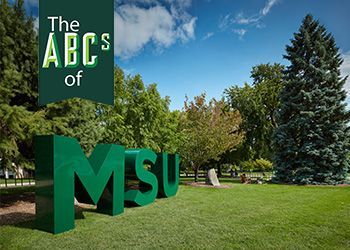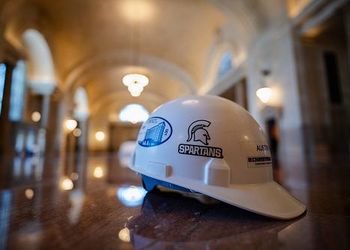Feature: Graduate Students at MSU

Graduate students at MSU are not just earning their degrees, they are contributing mightily to the economic development of the state and the country.
When Emma Setterington arrived at MSU in 2004 to begin her undergraduate work in biosystems engineering, her goal was not to improve the economy. Like most students, she sought a great education that would lead to a satisfying career.
Today, Setterington is a research scientist in biochemistry at Neogen Corporation, a company founded in 1982 to manufacture and market viable biotechnology developed at America’s land-grant universities. She works in Neogen’s food safety division in Lansing, MI, in an R&D lab developing rapid test kits for food safety applications.
“My biggest project currently is a portable, handheld detection system for sanitation monitoring in food production and processing facilities,” Setterington says.
She attributes her career success, in part, to her early research experience at MSU. In her second year as an undergraduate student, she began doing research under the supervision and guidance of Evangelyn C. Alocilja, professor of biosystems and agricultural engineering and an MSU AgBioResearch scientist.
Setterington worked on developing the magnetic nanoparticles that were later used in her master’s research in the development of a biosensor for rapid detection of E. coli.
“It was great preparation for my later graduate research since I gained familiarity with scientific literature, laboratory methods and practices, and the requirements of a graduate program,” Setterington says. She again worked in Alocilja’s Biosensors Lab as a graduate student, receiving her master’s degree in 2010.
Increasingly, students who earn graduate degrees at MSU are viewed as “economic engines,” major contributors to this country’s economic development— some even before they enter the workplace. Perhaps no one realizes the importance of this more than Satish Udpa, dean of MSU’s College of Engineering.
“If we want to maintain our market advantage, we have to push for graduate education and research, because that’s vital,” says Udpa. “Economic development in this country depends very much on our ability to be innovative and creative, and to translate creative ideas into the marketplace.”
Yet, at a time when the growth of U.S. research activities and graduate education is most critical, federal and state resources continue to diminish. It’s leading to some troubling statistics.
Trouble on the High-Tech Horizon
Michigan-based companies are struggling to find skilled workers to fill high-tech jobs due to the shortage of domestic students earning degrees in engineering and technology fields.
In countries like Singapore, China, Taiwan and South Korea, the number of researchers has grown at a much faster pace than in the United States. Likewise, the number of U.S. patents issued this past year have been on a downward trend. During the past several years, high-technology exports in the U.S. have steadily dropped, while countries in the Far East, the “tiger economies,” have seen their high-tech export figures continue to ramp up, according to data in Science and Engineering Indicators 2012, a report published by the National Science Foundation’s National Science Board.
To turn these statistics around, the U.S. must find ways to increase the number of domestic students who earn graduate degrees here in the U.S., as well as create jobs that will keep overseas students here in this country after they earn their degrees.
The number of students who earn advanced degrees from MSU has been on the rise since 2008. Approximately 2,500 students earned advanced degrees from MSU in the fiscal year 2010-2011. The College of Engineering awards about 150 MS and PhD degrees each year.
“Basic and applied research are both vital to keeping the economy humming,” says Udpa. “And we have a vested interest in keeping this economy going, because we want to maintain the kind of lifestyle we’ve enjoyed for the past 60 years.”
In contrast to applied research, which generally takes place in an industry setting, basic research takes place primarily in university labs. That’s credited mainly to an engineer named Vannevar Bush (1890-1974), who earned his PhD at MIT, became a faculty member there, and ultimately became MIT’s vice president and dean of engineering. He was known for his work on analog computing and started the company that eventually became Raytheon, one of the top 50 companies in the world today.
While serving as the head of the Manhattan Project’s National Defense Research Committee (the Manhattan Project was a research and development program undertaken during World War II to develop the first atomic bomb), Bush discovered something. The most creative phase in the lives of most scientists spanned the 20-30 years of age period. Bush realized that educational institutions would be the best place to capture the intellectual “hot spot” of these young people.
“Bush suggested that perhaps the most effective way to keep the basic research enterprise at its best was to fund universities to carry out basic research,” says Udpa. Bush also helped create the National Science Foundation in 1950 and authored a book titled Science—The Endless Frontier.
“Bush is the father of numerous things, and we don’t give him enough credit,” says Udpa. “Because of him, around the world,U. S. universities are now held in great regard; we are powerhouses when it comes to research and technology development.”
But the basic research carried out at universities across the country may not be of evident use right away; its value may not be realized for several years—or several decades.
When electricity was discovered in the 17th century, nobody thought “it’s going to provide electricity to power all our homes,” or “it will power industry.” Likewise, when quantum mechanics was discovered, people didn’t realize the impact it would have on semiconductor design, LEDs and an entire range of technologies. “Those concepts, those investments that we made a long time ago, are now paying off,” Udpa points out.
Investing in a Collaborative Environment
A collaborative environment is perhaps a university’s biggest advantage when it comes to new ideas and discoveries. Where else would you find a concentration of biologists, physicists, chemists, engineers and business people, for example, all in one location? Furthermore, who would ever think that studying flies and crickets could lead to the development of a high-tech device to help the hearing impaired? But that’s exactly what happened in one instance.
University biologists were studying the Ormia ochracea, a small, yellow nocturnal fly found in the southwest that uses crickets as a way to raise its young. The fly deposits its larvae on a male cricket, which it locates by listening for the cricket’s chirp.
Research was carried out to determine how the fly is capable of locating the crickets, even though its ears are spaced a miniscule distance apart. Despite this limitation, the fly can determine the direction of sound source with amazing precision.
“The tympanic membranes of opposite ears are connected mechanically, allowing localizing acoustic sources with resolution of less than two degrees (a 50-nanosecond delay), using eardrums separated by 0.5 mm,” Udpa explains. Hearing about the biologists’ work, an engineer asked Himself: “Could we replicate this in a circuit?” The result is a microphone-array hearing aid.
Investing in Creativity and Innovation
There has never been a more compelling need to invest more heavily in creative and innovative efforts.
“Many of our manufacturing industries— televisions, audio equipment, semiconductor memory, the photographic and film industry— have gone overseas,” says Udpa.“Your children won’t know what a ‘Kodak moment’ is. It’s gone.
“On the other hand, industries that did not exist just 10 years ago are now booming—like Google, Microsoft and Intel. Some companies die, but they are replaced by new types of industries.” That’s the concept of “creative destruction,” a term popularized by Austrian-American economist Joseph Schumpeter.
“Looking at innovation and creativity, we may be ahead of the game,” Udpa says. “Roughly 40 percent of the top 100 companies today—like Google and Intel— are in the United States. If you ask experts what contributes to innovation and creativity, and this concept of creative destruction, they will respond: a good business climate, an ecosystem that promotes innovation and creativity, and something called incremental engineering.”
For instance, Udpa points out, “Telephones were in business long before the iPhone came along.The iPad came out when others already had laptops. Steve Jobs took old concepts and put new ideas, new life back into them. That’s incremental engineering.”
Investing Early in the Research Enterprise
Even more important than a good business climate and innovative ideas is a well-trained workforce.
To ensure a workforce of well trained Spartan engineers, MSU’s College of Engineering is making investments in its research enterprise earlier in a student’s college career than most would expect.Along with the more than 800 graduate students you’d expect to find working in the labs each year, more than 200 of the college’s 3,400 undergraduate students work alongside faculty researchers.Some participate as early as freshman year through the MSU Honors College Professorial Assistantship Program. Next year, the College of Engineering expects to pair more than 300 undergraduates with research faculty members.
Like Setterington, Andrew Temme, currently an MSU electrical engineering doctoral student, was introduced to research in fall 2006, his freshman year at MSU. Temme, from Casper, Wyoming, came to MSU as a STARR Scholar—the recipient of the STARR Charitable Foundation Scholarship. The scholarship fund was established by an MSU graduate to benefit high character students from Wyoming. At MSU, Temme was an undergraduate research assistant in the Smart Microsystems Laboratory, where he was involved in the study of electroactive polymer sensors. In 2008, he joined the electromagnetic research group in MSU’s College of Engineering.
“I had been interested in electronics my whole life, but I really became interested in radios and electromagnetics during my junior year of high school as I was writing a History Days report on the use of amateur radio (also called ham radio) during emergencies,” recalls Temme. “I ended up getting my amateur radio License and have been interested ever since.
“My research experience as an undergraduate has served to shape me as a researcher,” he notes. “I have experience that many other graduate students do not have until a few years into their graduate studies.”
Temme, who earned his bachelor’s degree in electrical engineering in 2010 and received a National Science Foundation Graduate Research Fellowship that same year, explains his success as a researcher.“The most significant contributions have been the mentoring by older students which has taught me how to persevere, design my experiments, fix my experiments and also publish my experiments,” he notes.“These basics have set me up so that I am confident in starting my PhD project as an individual researcher and not as an assistant.”
He completed his master’s degree in 2011, working in the lab of Professor Edward Rothwell, the inventor of self-structuring antenna (SSA) technology. A patent for the antenna was granted to MSU in 2001, and Monarch Antennas (a joint venture between MSU and Delphi Technologies) was started to develop and market the technology.SSA improves the reliability of wireless devices such as cell phones and laptops, and has the potential to provide fewer dropped calls, smaller dead zones, faster downloads and longer battery life. Rothwell serves as the senior technical consultant to Monarch.
Temme has just begun work on his PhD, again in Rothwell’s lab, studying the effect that fire has on through-wall radars. “These types of radars can be used for search and rescue during emergencies,” Temme says. “There is existing research in through-wall radar, and on the interactions between forest fires and weather radar; however, I have not been able to find research that studies house fires and search and rescue radars together. Advances in this area could lead to companies producing search and rescue radars for the fire service.”
He expects to complete his PhD in 2014 and may then continue his work at a research and development laboratory or company, or at a small start up. “I took an entrepreneurship class while an undergrad and I’m open to pursuing a start up if the opportunity is available,” he says.
Research Investments Contribute to Economic Development
Meanwhile, back in Alocilja’s lab, new and continued research has recently led to the formation of a start up company— nanoRETE—which will develop and commercialize an inexpensive test for handheld biosensors to detect a broad range of threats such as E. coli, Salmonella, anthrax and tuberculosis. The mobile technology comes at only a fraction of the cost of the closest currently available competing technology, company officials say.
A significant leap forward in detection and diagnostic technology, the device utilizes novel nanoparticles with magnetic, polymeric and electrical properties developed by Alocilja.
“Our unique preparation, extraction and detection protocol enables the entire process to be conducted in the field, without significant training,” says Alocilja.“Results are generated in about an hour from receipt of sample to final readout, quickly identifying contaminants so that proper and prompt actions can be taken.”
nanoRETE is backed by Michigan Accelerator Fund I, a Grand Rapids, MI, investment partnership focused on Michigan based early stage life science and Technology companies.
“I would encourage graduate students, and even undergraduates, to network with industry professionals in their field as much as possible while still in school,” Setterington advises. “Graduate students—and MSU’s research program—can benefit from including industry representatives on their committees, so that research projects can be designed as much as possible to meet real world needs, increasing the rate of technology transfer from MSU to the market.”
Research and other grants at MSU totaled $495 million in 2009-10, while research expenditures in the College of Engineering currently stand at more than $50 million.
The cause has also been greatly helped by philanthropy, such as the recent transformational $7 million gift that will help expand MSU’s Dept. of Geological Sciences in the College of Natural Sciences, home to 4,900 undergraduate student majors and nearly 1,000 graduate students in physical, mathematical and biological sciences.
The gift, earmarked toward new professorships and graduate research fellowships, comes from an MSU graduate who wishes to remain anonymous but who clearly understands the value of graduate students and research.
As President Lou Anna K. Simon says, “Endowed professorships and endowed graduate fellowships are critical building blocks for excellence in every academic area.”
“Graduate fellowships are a cornerstone of strong research programs and this funding allows us to recruit the most capable,” says R. James Kirkpatrick, dean of the College of Natural Science.“The fellowships will provide funding for students to earn their degrees while undertaking advanced research alongside leading faculty.”
Meanwhile, Dean Udpa is increasing efforts to grow his college’s research enterprise. “Over the past six years, we have more than doubled the amount of research that we do in the College of Engineering,” he says. “We need to double that once again in the next three or four years in order to keep pace with what’s going on around the world. And that’s going to happen even though federal and state resources are constrained. We must continue to invest in these kinds of things. They represent the seed corn for maintaining our competitive edge.”
Laura Luptowski Seeley, ’80, is director of publications and media relations for MSU’s College of Engineering. She has worked on campus for more than 25 years.



